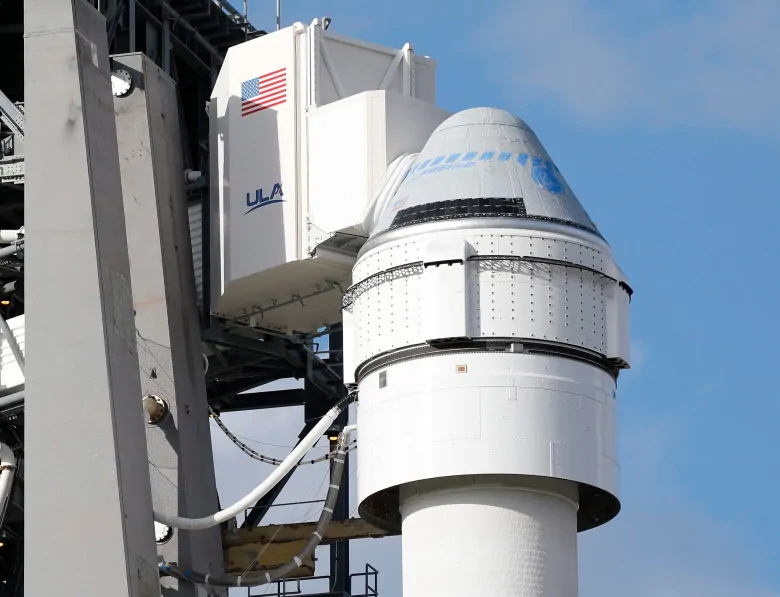Boeing's Starliner crew capsule rockets toward ISS on 1st space flight

Boeing’s new Starliner capsule rocketed toward the International Space Station on its first test flight Friday, a crucial dress rehearsal for next year’s inaugural launch with astronauts.
The Starliner carried Christmas treats and presents for the six space station residents, hundreds of tree seeds similar to those that flew to the moon on Apollo 14, the original air travel ID card belonging to Boeing’s founder and a mannequin named Rosie in the commander’s seat.
The test dummy — named after the bicep-flexing riveter of World War II — wore a red polka dot hair bandanna just like the original Rosie and Boeing’s custom royal blue spacesuit.
“She’s pretty tough. She’s going to take the hit for us,” said NASA’s Mike Fincke, one of three astronauts who will fly on the next Starliner and, as test pilots, take the hit for future crews.
Liftoff! Go <a href=”https://twitter.com/hashtag/Starliner?src=hash&ref_src=twsrc%5Etfw”>#Starliner</a>! Go <a href=”https://twitter.com/hashtag/AtlasV?src=hash&ref_src=twsrc%5Etfw”>#AtlasV</a>! <a href=”https://t.co/wHbRh4u06O”>pic.twitter.com/wHbRh4u06O</a>
—@BoeingSpace
As the astronauts watched from nearby control centres, a United Launch Alliance Atlas V rocket carrying the capsule blasted off just before sunrise from Cape Canaveral Air Force Station. It was a one-day trip to the space station, putting the spacecraft on track for a docking Saturday morning.
SpaceX could carry astronauts by spring
This was Boeing’s chance to catch up with SpaceX, NASA’s other commercial crew provider that completed a similar demonstration last March. SpaceX has one last hurdle — a launch abort test — before carrying two NASA astronauts in its Dragon capsule, possibly by spring.
The U.S. needs competition like this, NASA administrator Jim Bridenstine said Thursday, to drive down launch costs, boost innovation and open space up to more people.
“We’re moving into a new era,” he said.
The space agency handed over station deliveries to private businesses, first cargo and then crews, to focus on getting astronauts back to the moon and on to Mars.
Commercial cargo ships took flight in 2012, starting with SpaceX. Crew capsules were more complicated to design and build, and parachute and other technical problems pushed the first launches from 2017 to now next year.
U.S. astronauts reliant on Soyuz spacecraft since 2011
It’s been nearly nine years since NASA astronauts have launched from the U.S. The last time was July 8, 2011, when Atlantis — now on display at Kennedy Space Center — made the final space shuttle flight.
Since then, NASA astronauts have travelled to and from the space station via Kazakhstan, courtesy of the Russian Space Agency. The Soyuz rides have cost NASA up to $86 million US apiece.
“We’re back with a vengeance now,” Florida Gov. Ron DeSantis said from Kennedy, where crowds gathered well before dawn.

Chris Ferguson commanded that last shuttle mission. Now a test pilot astronaut for Boeing and one of the Starliner’s key developers, he’s assigned to the first Starliner crew with Fincke and NASA astronaut Nicole Mann. A successful Starliner demo could see them launching by summer.
“This is an incredibly unique opportunity,” Ferguson said on the eve of launch.
Mann juggled a mix of emotions: excitement, pride, stress and amazement.
“Really overwhelmed, but in a good way and really the best of ways,” she said.
What Starliner is like
Built to accommodate seven, the white capsule with black and blue trim will typically carry four or five people. It’s five metres tall with its attached service module and 4.5 metres in diameter.
Every Starliner system will be tested during the eight-day mission, from the vibrations and stresses of liftoff to the Dec. 28 touchdown at the Army’s White Sands Missile Range in New Mexico. Parachutes and air bags will soften the capsule’s landing. Even the test dummy is packed with sensors.
Boeing Starliner launch this morning. <a href=”https://twitter.com/NWSJacksonville?ref_src=twsrc%5Etfw”>@NWSJacksonville</a> <a href=”https://t.co/2ZcwPeSRED”>pic.twitter.com/2ZcwPeSRED</a>
—@great_curtscott
Bridenstine said he’s “very comfortable” with Boeing, despite the prolonged grounding of the company’s 737 Max jets. The spacecraft and aircraft sides of the company are different, he noted. Boeing has long been involved in NASA’s human spacecraft program, from Project Mercury to the shuttle and station programs.
Boeing began preliminary work on the Starliner in 2010, a year before Atlantis soared for the last time.
In 2014, Boeing and SpaceX made the final cut. Boeing got more than $4 billion to develop and fly the Starliner, while SpaceX got $2.6 billion for a crew-version of its Dragon cargo ship.
NASA wants to make sure every reasonable precaution is taken with the capsules, designed to be safer than NASA’s old shuttles.
“We’re talking about human spaceflight,” Bridenstine cautioned. “It’s not for the faint of heart. It never has been, and it’s never going to be.”





